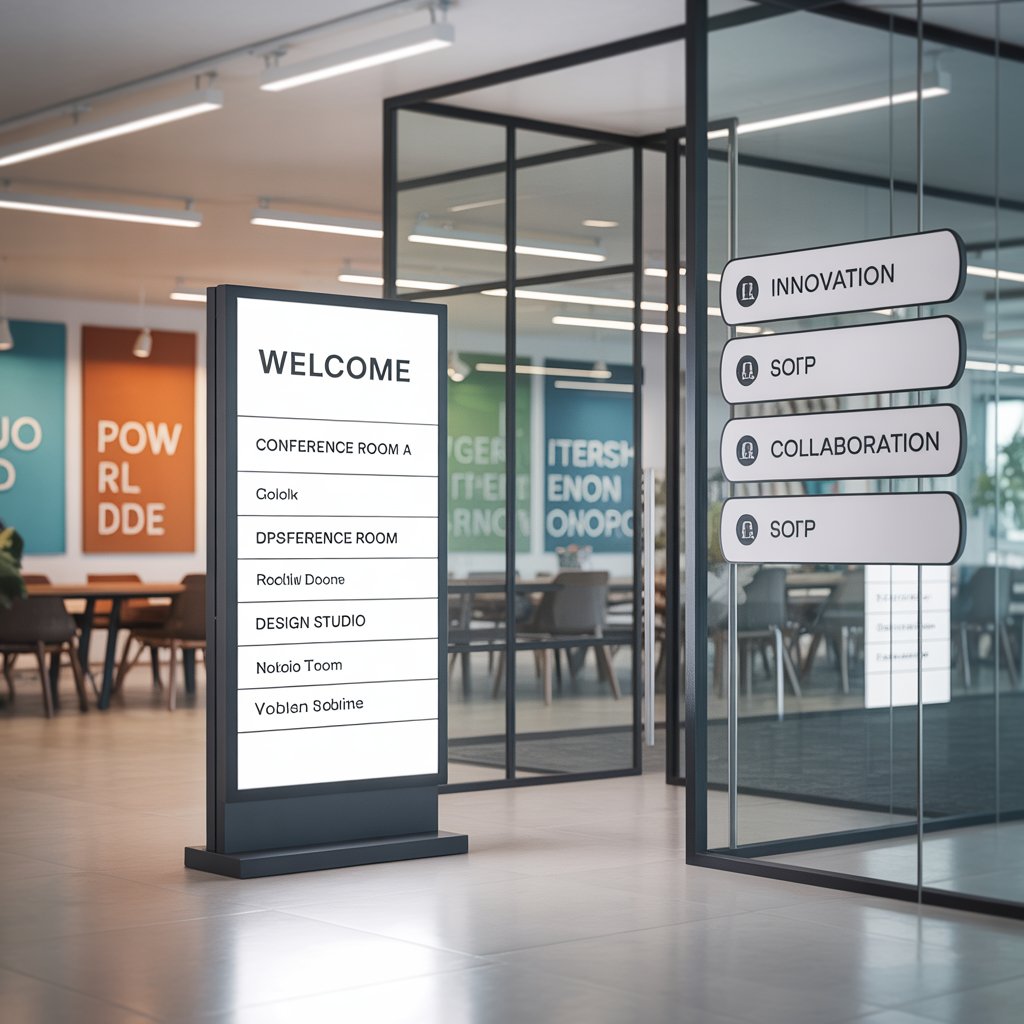First Impressions Matter: Especially in Business
Have you ever walked into an office building and felt immediately confused or impressed? Maybe the front desk was hidden, signs were missing, or there was nothing visually welcoming or informative about the space. Whether you’re a property manager, building owner, or signage company, this is your wake-up call.
Signage isn’t just a finishing touch. It’s your building’s voice, guiding, informing, and welcoming everyone who walks through your doors. When done right, office signage can reduce confusion, boost brand presence, improve accessibility, and even increase tenant satisfaction.
Let’s explore everything you need to know about office building signage, from types and materials to compliance laws and brand integration.

Types of Office Building Signage
Interior Signage: Clear Navigation & Brand Presence
Indoor office signage serves as the backbone of internal navigation and communication. Common types include:
- Directory signs: Located in lobbies to show floor plans and tenant listings.
- Room signs: Identifying offices, restrooms, conference rooms, etc.
- Wall graphics: Often used for inspiration, branding, or company values.
- Office welcome signs: Positioned at receptions to create an inviting atmosphere.
Did you know? 58% of visitors say a well-placed office welcome sign positively affects their impression of a business.
Exterior Signage: Visibility from the Outside
Signs for office buildings outside should command attention while guiding people efficiently:
- Monument signs: These are found near entrances for easy identification.
- Building-mounted signs: Company logos or names that are visible from a distance.
- Directional signage: Guides delivery drivers, clients, and guests to parking or entrances.
Specialty Signage
These include glass office signs, illuminated signs, digital displays, or branded wall installations that enhance aesthetics and functionality.
Choosing the Right Materials for Office Signage: Durability, Style, and Cost
Material choice impacts both longevity and brand perception. Here’s a simple breakdown:
| Material Type | Best For | Durability | Cost |
| Acrylic | Interior logos, nameplates | High | Medium |
| Aluminium Composite | Exterior signs | Very High | High |
| Vinyl | Wall murals, window graphics | Medium | Low |
| Glass | Premium branding for modern interiors | High | High |
| Foam Board | Temporary internal messaging | Low | Low |
Tip: Choose materials that reflect your brand’s tone. A law firm may go for brushed metal, while a creative agency might choose colorful acrylic.
ADA Compliance and UK Regulations: What Every Property Manager Should Know
In both the US and the UK, there are legal standards that signage must meet, especially when it comes to accessibility.
ADA Compliance (US)
The Americans with Disabilities Act (ADA) requires:
- High contrast and legible fonts
- Braille and tactile lettering on room signs
- Mounting signs at consistent, accessible heights
Failing to meet ADA standards not only affects your building’s usability, it can also result in legal penalties.
UK Signage Compliance
In the UK, BS 8300 and the Equality Act 2010 dictate that signage must:
- Be readable to people with visual impairments
- Include tactile or visual contrast elements
- Provide clear emergency and fire safety information
Example: A facility manager in Manchester upgraded their corporate building signage to comply with BS 8300 and saw an 18% drop in navigation-related complaints.

Effective Wayfinding and Placement Strategies for Office Buildings
Wayfinding is more than arrows, it’s a strategy.
What’s the Best Way to Lay Out Signage?
- Create a signage hierarchy: From general building directories to individual room labels.
- Walk the space like a visitor: Identify pain points and confusion zones.
- Follow eye-level rules: Most signs should be mounted between 48 and 60 inches from the floor.
- Don’t overcrowd: Use minimal wording and clear icons.
- Reinforce key decision points: Elevators, stairwells, restrooms, and reception areas.
Aligning Office Signage with Branding and Building Aesthetics
Your signage reflects your brand’s personality. It should blend seamlessly with the interior design and reinforce your identity.
- Use brand colors and fonts where appropriate
- Integrate your logo subtly into door plaques or lobby signs
- Ensure your office signage design aligns with décor (modern, industrial, classic)
FAQ: What People Also Ask About Office Signage
What types of signs are used in office buildings?
Directory signs, room IDs, welcome signage, directional signs, and branding graphics.
How do I choose the best material for office signage?
Factor in placement (indoor/outdoor), expected lifespan, brand style, and budget.
Is ADA compliance mandatory for indoor office signage?
Yes, in the US. Braille, tactile lettering, and proper placement are required by law.
How does signage impact visitor experience?
Good signage reduces confusion, enhances professionalism, and improves accessibility.
What’s the role of branding in office signage?
It reinforces brand presence, builds trust, and leaves a lasting impression on visitors.
Signage Isn’t an Afterthought: It’s a Strategy
Great office signage doesn’t just direct; it communicates, welcomes, and protects your brand image. Whether you’re overseeing a multi-tenant commercial building or a boutique office space, investing in smart signage design pays off in professionalism and functionality.
Ready to Upgrade Your Office Signage?
Looking to make your office building easier to navigate and more impressive to walk into?
Explore our commercial signage solutions tailored for property managers, architects, and corporate spaces. Whether it’s glass office signs, directory boards, or custom office sign indoor installations, we’ll help you make every corner count.
Get in touch for a free signage consultation today.





